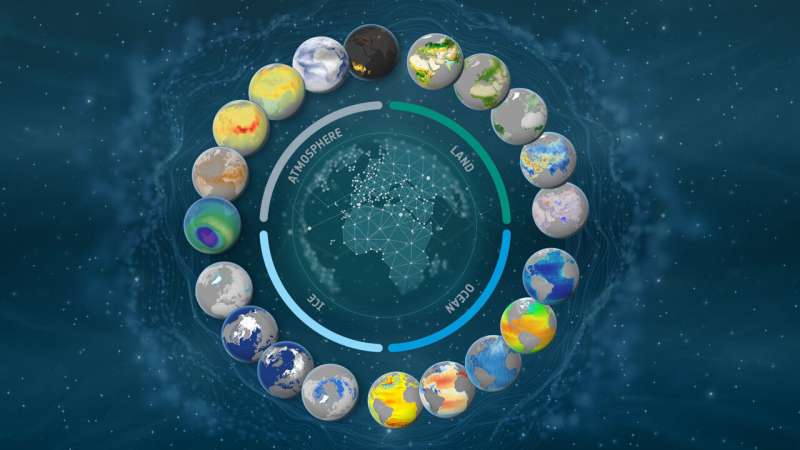This article has been reviewed according to Science X's editorial process and policies. Editors have highlighted the following attributes while ensuring the content's credibility:
fact-checked
trusted source
proofread
Taking climate action with Earth observation

As global temperatures records are smashed and greenhouse gas emissions reach new highs, a new report from the UN Environment Programme finds that current pledges under the Paris Agreement put the world on track for a 2.5°C–2.9°C temperature rise this century—pointing to the urgent need for increased climate action.
The report is timely as nearly 200 nations gather in the coming two weeks at the United Nations COP28 Climate Change Summit to conclude the world's first ever "Global Stocktake" on climate change. Swift and sustained climate action is needed to avoid the worst consequences of climate change. Satellites are critical tools in the quest to tackle climate change and monitor progress towards a lower-emissions and more resilient world.
Taking stock of global climate action
Nearly 200 countries agreed under the 2015 Paris Agreement to limit global warming to 2°C above preindustrial times and to aim for 1.5°C to avoid the most severe and irreversible impacts of climate change.
The global stocktake will evaluate the world's collective progress towards the mitigation and adaptation and identify gaps to achieve the Paris Agreement as well as opportunities to bridge them. Its initial key findings, published in September, revealed just how far the world is from achieving the Paris Agreement's goals and emphasizes the closing window of opportunity.
It stresses the need for stronger climate action before the next global stocktake in 2028 or we may witness the devastating reality of global temperatures surpassing the 1.5°C mark.
The first-ever assessment, or stocktake, will conclude during this year's UN Climate Change Conference (COP28) taking place in Dubai, United Arab Emirates. By the end of COP28, countries must agree on how they will leverage the stocktake's findings to keep the global goal of limiting temperature rise to 1.5°C and address the impacts of climate change.
If undertaken effectively, the global stocktake can provide an opportunity to leverage decisions and accelerate ambition in climate action plans.
ESA Director of Earth Observation Programs, Simonetta Cheli, comments, "The global stocktake is a moment of truth. We know that currently we are not on track to limit global warming and the window to act is closing.
"Satellites provide us with a systematic, global and continuous coverage of our planet, including the areas most difficult to reach. We cannot manage what we cannot measure: satellite observations provide early warnings of change, they improve climate predictions and deliver the hard facts needed for effective international climate action."
Accurate reporting
For this process to be robust, accurate and consistent reporting is needed at a national scale. Currently, national greenhouse gas emissions inventories, which are reported to the UN Framework Convention on Climate Change (UNFCCC) are compiled using emissions factors and national statistics.
To enhance accuracy, the Intergovernmental Panel on Climate Change (IPCC) encourages countries to verify reported emissions against independent measurements, such as Earth observation data, to promote transparency and align emissions reporting with real-world conditions.
Research from ESA's Regional Carbon Assessment and Processes project (RECCAP-2) developed and implemented a comprehensive framework to compare national inventories against state-of-the-art systems making use of satellite observations.
The project researchers combine satellite-derived observations and in situ measurements with inversion models that help to factor the "flux" or movement of greenhouse gas emissions between land and atmosphere, to backtrack greenhouse gas concentrations to their origin.
This top-down approach offers a full picture of the emissions that accumulate in the atmosphere at the country scale. This is then used to check national inventories to enhance greenhouse gas reporting.
It can help reduce uncertainties in national greenhouse gas inventories, identify additional emissions reduction opportunities and provide nations with timely guidance on progress towards their emission reduction strategies and pledges.
Currently, only large, high-emitting countries can be assessed. But with denser satellite sampling anticipated in the coming years, more countries are set to benefit.
Building on similar research methods, ESA is developing World Emission—an emissions-monitoring service that leverages satellite data from Copernicus, from space agencies such as NASA and the Japan Aerospace Exploration Agency (JAXA), and complementary ground-based measurements.
This unique global coverage project will generate maps for carbon dioxide, methane and several atmospheric pollutants. It will provide essential information for policymakers, governments, national reporting agencies and subsidiary bodies to enhance pollutant and greenhouse gas emissions inventories.
This is just one example of how Earth observation can demonstrate its uniqueness and excellence to complement traditional information, contributing significantly to the overall drive for climate change mitigation.
New mission to detect human-made emissions
On top of the Copernicus Sentinel-5P satellite, new satellite missions launched in the coming years will provide a much denser sampling of atmospheric carbon dioxide and methane. ESA is developing the Copernicus Anthropogenic Carbon Dioxide Monitoring (CO2M) mission—the first satellite mission to measure how much carbon dioxide is released into the atmosphere specifically through human activity.
By providing a unique and independent source of information, CO2M will be key to assessing the effectiveness of policies aimed at curbing emissions at both national and global scale, enabling countries to track and show how they are progressing against their decarbonization commitments.
The mission is anticipated to provide data to support the second global stocktake that will conclude in 2028, as well as the dramatic decarbonization of Europe's economized needed to deliver the EU Green Deal.
Provided by European Space Agency




















